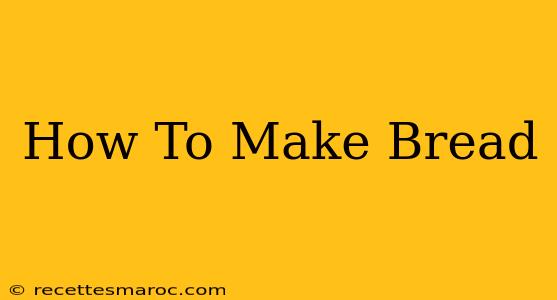Making bread might seem daunting, but it's a rewarding process that's surprisingly accessible. This comprehensive guide will walk you through each step, from gathering ingredients to achieving that perfect golden-brown crust. Whether you're a complete novice or looking to refine your technique, you'll find valuable tips and tricks here to help you bake delicious homemade bread.
Essential Ingredients for Homemade Bread
Before you begin, ensure you have these key ingredients:
- Flour: Bread flour is ideal for its high protein content, which contributes to gluten development and a chewier texture. All-purpose flour works in a pinch, but the results might be slightly less impressive.
- Water: Lukewarm water is best for activating the yeast. The exact amount might vary depending on the flour's absorption rate.
- Yeast: Active dry yeast is the most common type. Make sure it's fresh; expired yeast won't properly activate.
- Salt: Salt controls yeast activity and enhances flavor. Don't skip it!
- Sugar (Optional): A small amount of sugar can feed the yeast and contribute to browning.
Step-by-Step Bread Making Process
This guide outlines the basic steps for making a simple loaf of bread. Variations exist, of course, but this foundation will allow you to explore more complex recipes later.
1. Activate the Yeast
In a large bowl, combine lukewarm water, a teaspoon of sugar (if using), and the yeast. Let it sit for 5-10 minutes until foamy. This proves your yeast is alive and active. If it doesn't foam, your yeast is likely dead, and you'll need a fresh batch.
2. Combine Ingredients
Add the flour and salt to the yeast mixture. Stir with a wooden spoon or spatula until a shaggy dough forms.
3. Kneading the Dough
This is where the magic happens! Kneading develops gluten, creating a strong, elastic dough that will rise beautifully. Knead the dough for 8-10 minutes, either by hand on a lightly floured surface or using a stand mixer with a dough hook. The dough should be smooth and elastic, springing back slightly when you poke it.
4. First Rise (Bulk Fermentation)
Place the dough in a lightly oiled bowl, turning to coat. Cover the bowl with plastic wrap or a damp cloth and let it rise in a warm place for about 1-1.5 hours, or until doubled in size.
5. Shaping the Dough
Gently punch down the dough to release the air. Shape it into a round or oblong loaf.
6. Second Rise (Proofing)
Place the shaped dough in a greased loaf pan or on a baking sheet lined with parchment paper. Cover it and let it rise for another 30-45 minutes, or until almost doubled.
7. Baking the Bread
Preheat your oven to 375°F (190°C). Bake for 30-35 minutes, or until the bread is golden brown and sounds hollow when tapped on the bottom.
8. Cooling and Enjoying
Remove the bread from the oven and let it cool completely on a wire rack before slicing and serving. This allows the crumb to set properly.
Tips for Bread Making Success
- Use a Kitchen Scale: For consistent results, measure ingredients by weight rather than volume.
- Don't Overknead: Overkneading can lead to a tough loaf.
- Warm Environment: A warm environment is crucial for proper rising. You can even use a proofer for optimal results.
- Experiment with Flavors: Once you master the basics, try adding herbs, seeds, or even different types of flour to create unique loaves.
Making bread is a journey of discovery. Don't be discouraged if your first loaf isn't perfect. With practice and patience, you'll be baking delicious, artisan bread in no time! Enjoy the process and the wonderful aroma that fills your kitchen.

